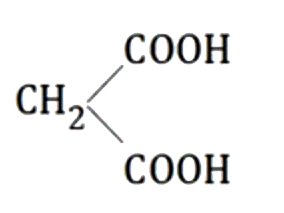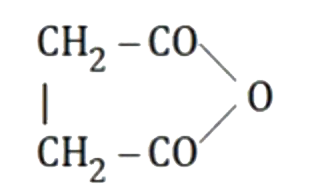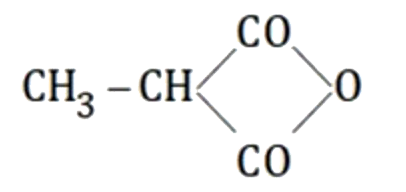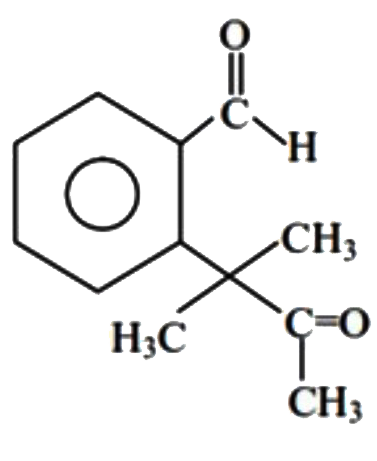In the given reaction CH3−COOH(i) Red −P+Br2−−−−−−−−−−→(ii) NaCN(iii) H2O/H⊕(X)
'X' will be

COOH−CH2−CH2−COOH


The correct Answer is:A
To solve the given reaction step by step, we will analyze each part of the reaction involving acetic acid (CH₃COOH) and the reagents provided.
Step 1: Understanding the Reaction
We start with acetic acid (CH₃COOH). The first step involves treating it with red phosphorus and bromine (Br₂). This is known as the Hell-Volhard-Zelinsky (HVZ) reaction, which is a halogenation reaction at the alpha position of the carboxylic acid.
Step 2: Halogenation of Acetic Acid
In the presence of red phosphorus and Br₂, the hydrogen atom at the alpha position (the carbon adjacent to the carboxylic acid) is replaced by a bromine atom. Thus, the structure changes from CH₃COOH to:
CH2BrCOOH
This compound is known as alpha-bromoacetic acid.
Step 3: Nucleophilic Substitution with NaCN
Next, we treat the alpha-bromoacetic acid with sodium cyanide (NaCN). In this step, the cyanide ion (CN⁻) acts as a nucleophile and attacks the carbon atom that is bonded to the bromine atom (the electrophilic center). The bromine atom is a good leaving group, allowing the reaction to proceed smoothly.
The product of this reaction will be:
CH2CNCOOH
This compound is known as alpha-cyanoacetic acid.
Step 4: Hydrolysis of the Cyanide Group
The final step involves hydrolysis of the cyanide group in the presence of water (H₂O) and an acid (H⁺). During hydrolysis, the cyanide group (CN) is converted into a carboxylic acid group (COOH). The reaction can be represented as follows:
CH2CNCOOH+H2O→CH2COOH+NH3
Thus, the final product 'X' after hydrolysis is:
CH2COOH
This compound is known as 2-hydroxypropanoic acid or lactic acid.
Conclusion
The final product 'X' is 2-hydroxypropanoic acid (lactic acid).
Summary of Steps
1. Halogenation: Acetic acid (CH₃COOH) reacts with Br₂ in the presence of red phosphorus to form alpha-bromoacetic acid (CH₂BrCOOH).
2. Nucleophilic Substitution: Alpha-bromoacetic acid reacts with NaCN to form alpha-cyanoacetic acid (CH₂CNCOOH).
3. Hydrolysis: Alpha-cyanoacetic acid undergoes hydrolysis to yield 2-hydroxypropanoic acid (lactic acid, CH₂COOH).
We start with acetic acid (CH₃COOH). The first step involves treating it with red phosphorus and bromine (Br₂). This is known as the Hell-Volhard-Zelinsky (HVZ) reaction, which is a halogenation reaction at the alpha position of the carboxylic acid.
In the presence of red phosphorus and Br₂, the hydrogen atom at the alpha position (the carbon adjacent to the carboxylic acid) is replaced by a bromine atom. Thus, the structure changes from CH₃COOH to:
Next, we treat the alpha-bromoacetic acid with sodium cyanide (NaCN). In this step, the cyanide ion (CN⁻) acts as a nucleophile and attacks the carbon atom that is bonded to the bromine atom (the electrophilic center). The bromine atom is a good leaving group, allowing the reaction to proceed smoothly.
The final step involves hydrolysis of the cyanide group in the presence of water (H₂O) and an acid (H⁺). During hydrolysis, the cyanide group (CN) is converted into a carboxylic acid group (COOH). The reaction can be represented as follows:
The final product 'X' is 2-hydroxypropanoic acid (lactic acid).
1. Halogenation: Acetic acid (CH₃COOH) reacts with Br₂ in the presence of red phosphorus to form alpha-bromoacetic acid (CH₂BrCOOH).
2. Nucleophilic Substitution: Alpha-bromoacetic acid reacts with NaCN to form alpha-cyanoacetic acid (CH₂CNCOOH).
3. Hydrolysis: Alpha-cyanoacetic acid undergoes hydrolysis to yield 2-hydroxypropanoic acid (lactic acid, CH₂COOH).
Similar Questions
Knowledge Check
- Question 1 - Select One
In the given reaction [X] will be:
C6H5−C∣∣O−HNH2OH/H⊕−−−−−−−−→[X]Aonly syn oximeBonly anti aximeCmixture of syn and anti oximeDsecondary amide - Question 2 - Select One or More
In the given reaction:
Ph−C∣∣O−CH3H2N−OH−−−−−−−−→H⊕(X)PCl5−−−−−→Δ(Y) Y will beAPh−C∣∣O−NH−CH3BH3C−O∣∣C−NH−PhCPh−CH2−O∣∣C−NH2DPh−CH2−CN
In the given reaction CH3CHO(i)HCN/Ca(CN)2−−−−−−−−−−−−→(ii)H3O+[X] [X] will be
View SolutionIdentify (A) in the following reaction sequence
AGives Positiveiodoform test(i) CH3MgBr−−−−−−−−−−−→(ii) H+,H2O(iii) Conc. H2SO4/Δ(B)Oy/Zn,H2O−−−−−−−→ View Solution
View SolutionIn the given reaction CH3−cH2COOH(i)CH3Li (excess)(ii)H3O⊕−−−−−−−−−−−−−−−−−−→[X]
[X] will beView SolutionIn the given reaction sequence
CH3CHO(i)NaCN/HCl−−−−−−−−−−−−→(ii)H2O+(A)Fenton−−−−−−→reagent(B), B will beView SolutionIn the given reaction,
CH3−CH∣CH3−O∣∣C−CH2−CH3CF3CO3H−−−−−→(X)
as main product, 'X' will beView SolutionIn the given reaction C6H5−O∣∣C−CH3(i)C2H8MgBr−−−−−−−−→(ii)H2O/H+(X) X will be
View Solution
